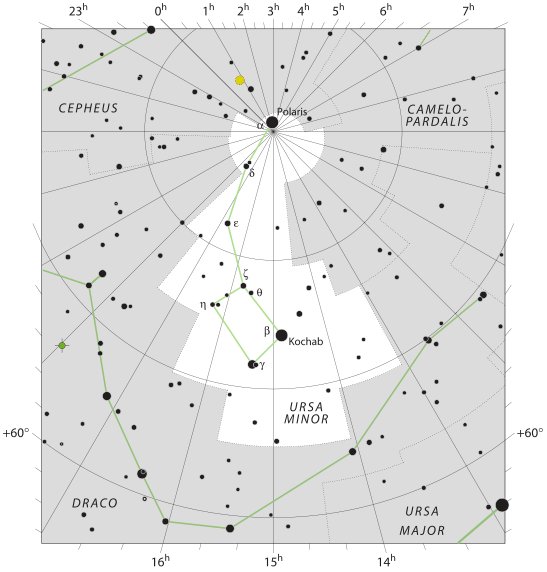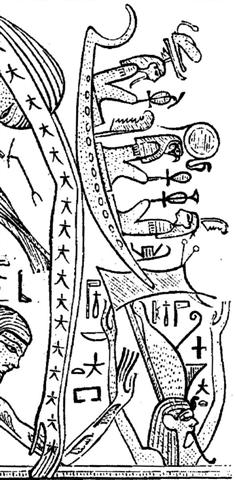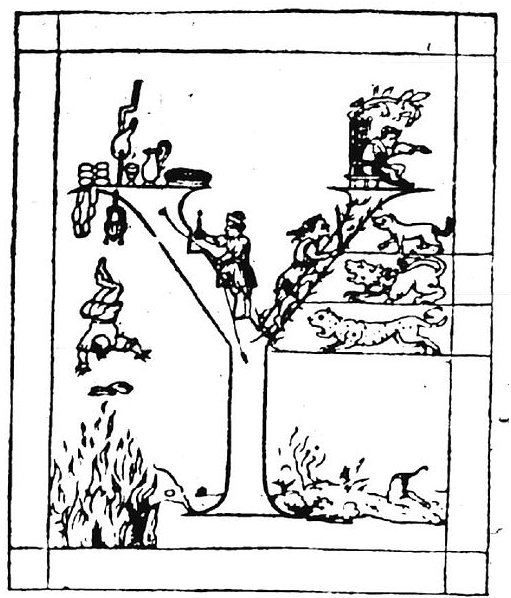When Atlas once upon a time had risen
simultaneously with the Sun at the northern
winter solstice, at that time of the (Y)ear the Full Moon would have been
visible at
the opposite side of the sky dome, viz.
at the place aloft (Poike, upraised sky, high summer).
The Moon was two-fold, for in order to reach a
whole number you had to count 2 * 29½ = 59
(= 472 / 8) nights.
I am still convinced that there was 1 and only 1
glyph per right ascension day. Ear-ly, though, I
speculated if not such long texts as that on the
Tahua tablet would have had 2 glyphs per right
ascension day.
However, its basic cycle could have
been that of Venus:
|
SYNODIC CIRCUIT OF VENUS |
|
Black |
8 |
|
Morning Star |
263 |
|
Black |
50 |
|
Evening Star |
263 |
|
Sum |
584 |
For
584 + 80 = 664 = number of glyphs on side b of
the A tablet. And the number of glyphs on side a =
670 = 80 + 584 + 6 = 1334 - 664:
|
59 |
 |
520 |
 |
13 *
37 |
 |
270 |
 |
|
Ab1-1 |
Ab7-26 |
Aa5-7 |
Aa8-26 |
|
580 =
20 * 29 |
26
* 29 = 755 - 1 |
|
1334 = 5 * 254 +
64 =
46 *
29 = 1335 - 1 = 5 * 267 - 1
267 =
September 24 |
|
236
(Moon) + 263 (Venus) = 499.
...
Notably the Raven, who was ascending in
day 236 (= 8 * 29½) in Roman times
('August 24),
had moved ahead due to the precession
with 27 days to 'a clean cup' in day 263
at the time of rongorongo ...
|
|
OCT 26 (299) |
27 (*220) |
28 |
29 |
30 |
31 |
 |
 |
 |
 |
 |
 |
|
Ga8-16 |
Ga8-17 (220) |
Ga8-18 |
Ga8-19 |
Ga8-20 |
Ga8-21 |
|
ζ
Pavonis (283.4),
λ
Cor. Austr. (283.6),
DOUBLE DOUBLE =
ε
Lyrae
(283.7),
ζ
Lyrae (283.8)
*242.0 = *283.4 - *41.4 |
South Dipper-8 (Unicorn)
Φ
Sagittarii
(284.0),
μ
Cor. Austr. (284.6),
η
Cor. Austr.,
θ
Pavonis (284.8) |
SHELIAK (Tortoise) = β Lyrae,
ν
Lyrae (285.1),
ο Draconis
(285.5). λ
Pavonis (285.7)
ATLAS (27 Tauri) |
χ
Oct. (286.0),
AIN AL RAMI (Eye of the Archer) = ν
Sagittarii
(286.2),
υ Draconis (286.4),
δ
Lyrae (286.3),
κ
Pavonis (286.5),
ALYA (Fat Tail) = θ Serpentis
(286.6)
*245.0 = *286.4 - *41.4 |
ξ Sagittarii (287.1), ω Pavonis
(287.3), ε Aquilae, ε Cor. Austr.,
SULAPHAT (Little Tortoise Shell) = γ
Lyrae (287.4),
λ Lyrae (287.7),
ASCELLA (Armpit) = ζ Sagittarii,
BERED = i Aquilae (Ant.)
(287.9)
*246.0 = *287.4 - *41.4 |
Al Na'ām-18 (Ostriches) /
Uttara Ashadha-21 (Elephant tusk,
small bed)
NUNKI = σ Sagittarii (288.4),
ζ Cor. Austr. (288.5),
MANUBRIUM = ο Sagittarii
(288.8), ζ Aquilae (288.9)
*247.0 = *288.4 - *41.4 |
.jpg)

... I wan't a clean cup, interrupted
the Hatter: let's all move one place
on. He moved as he spoke, and the
Dormouse followed him: the March
Hare moved into the Dormouse's
place, and Alice rather unwillingly
took the place of the March Hare.
The Hatter was the only one who got
any advantage from the change; and
Alice was a good deal worse off than
before, as the March Hare had just
upset the milk-jug into his plate
... |
|
Dec 29 (363) |
April 11
+ 263 |
31 (*285) |
Jan 1 |
2 |
3
(368) |
|
°Dec 25 (359) |
26 (*280) |
27 |
28 |
29 |
30 (364) |
|
'Dec 2 (336) |
3
(*257) |
4 |
5 |
6 |
7
(341) |
|
"Nov 18 (312) |
19 (*243) |
20 |
21 |
22 |
23 (327) |
|
... The correspondence between the
winter solstice and the kali'i
rite of the Makahiki is
arrived at as follows: ideally, the
second ceremony of 'breaking the
coconut', when the priests assemble
at the temple to spot the rising of
the Pleiades, coincides with the
full moon (Hua tapu) of the
twelfth lunar month (Welehu). In
the latter eighteenth century, the
Pleiades appear at sunset on 18
November. Ten days later (28
November), the Lono effigy
sets off on its circuit, which lasts
twenty-three days, thus bringing the
god back for the climactic battle
with the king on 21 December, the
solstice (= Hawaiian 16 Makali'i). The
correspondence is 'ideal' and only
rarely achieved, since it depends on
the coincidence of the full moon and
the crepuscular rising of the
Pleiades
... |
|
CLOSE TO THE FULL MOON: |
|
APRIL 27 |
28 (4 * 29½) |
29 |
30 (302 - 183) |
MAY 1 (11 * 11) |
2
(*42) |
|
SIRIUS = α Canis Majoris
(101.2),
ψ5 Aurigae (101.4),
ν Gemini (101.6), ψ6 Aurigae (101.7)
*60.0 = *101.4 - *41.4 |
τ
Puppis (102.2),
ψ7 Aurigae (102.4)
*61.0 = *102.4 - *41.4 |
Mash-mashu-sha-Risū-9 (Twins of the
Shepherd)
θ
Gemini (103.0),
ψ8
Aurigae (103.2),
ALHENA =
γ
Gemini
(103.8),
ψ9
Aurigae (103.9) |
ADARA (Virgins) = ε Canis Majoris
(104.8) |
ω Gemini (105.4),
ALZIRR (Button) =
ξ
Gemini
(105.7),
MULIPHEIN (Oaths) = γ Canis Majoris
(105.8),
MEKBUDA (Contracted) = ζ Gemini
(105.9)
*64.0 = *105.4 - *41.4 |
7h (106.5)
No star listed (106) |
 |
|
June 30 (*101) |
July 1 |
2 |
3
(*104) |
4 |
5
(186) |
|
°June 26 |
27 |
28 |
29 (*100) |
30 |
°July 1 (182) |
|
'June 3 |
4 |
5 |
6
(*77) |
7 |
8
(159) |
|
"May 20 |
21 |
22 |
23 (*63) |
24 |
25 (145) |
584 + 6 = 590 = 20 * 29½. I.e. we can guess the
text on side a of the A tablet was related to
the Moon and its side b to Venus.
Both Moon and Venus were two-fold.
... When I asked if I could
bring one of the archaeologists along on the
promised visit to his cave, Atan Atan was at
first reluctant, but on second thought he found
that this could do no harm since the cave was
now mine and would be emptied anyhow. The
objects, however, were to be taken directly on
board the ship and not shown to anyone before we
left the island. Whatever was said and done
afterwards would not matter to him, he added .
The stone skull with the
peculiar pits on top brought to mind a small and
crude stone cranium already found
archaeologically behind the Vinapu temple
plaza on the south side of the island, and a
second examination of this piece showed much to
our surprise that here also two deep pits had
been carved on the forehead, asymmetrically on
each side of the sagittalis
...
Ferdon ... who conducted
personal interrogations among the Easter
Islanders in his own work team at Orongo,
and who was to participate in the opening of
Atan Atan's cave, wrote: 'I later learned from
quite a different source that such depressions
were for placing ground human bone to create
maximum power for this key, or guardian
stone.' Obviously, this was not an idea
originating with Atan Atan and his cave .
On March 18, the day
preceding the nocturnal cave visit, I attended
an Easter Island wedding in Hangaroa
village. During the outdoor feast that followed
I was approached by old Victoria Atan,
Tahutahu, who grabbed my hand with both of
hers and clung on to me, asking me with a
friendly but most intense look to bring 'good
luck' for herself and her family. It was not
then quite clear what she meant, but next day it
became evident as two of her nephews performed a
rather ludicrous and bizarre rite made up for
the occasion in the mess tent of our camp .
Atan Atan and his brother
Esteban had asked if they could come to us for a
Norwegian meal for 'good luck'. They explained
that later that night we were to eat from their
own umu takapu, or ceremonial earth oven,
which their aunt Tahutahu was to prepare
in the neighborhood of the cave.
Esteban Atan was brought
along, said Atan, to make up an even number
since I had asked to bring along my companion,
Ferdon. An uneven number caused 'bad luck'. When
I next asked for the participation even of the
expedition photographer ... Atan Atan once more
felt ill at ease, until again he made our number
even: instead of sending away his brother he
insisted that his brother's best friend,
Henrique Teao, be brought with us also. The
senior brother, Pedro Atan, was ill with
influenza, but Henrique Teao was just then
bringing along logs to our camp to serve as
skids, as the group that had formerly erected
the statue were now to reveal how these stone
giants were transported.
Henrique, who later drowned
at sea with his friend Esteban Atan when they
tried to escape from the island, had just then
started to bring me secret sculptures, and it is
not unlikely that the two Atan brothers were
aware of the fact.
Our Easter Island maid was
relieved for the occasion by the ship's steward
as our select little group sat down to a
Scandinavian smörgaasbord and whispered
about our secrets. The three islanders first
made the sign of the cross and murmured a little
grace, whereupon Atan Atan looked up and
explained as if almost embarrassed, that this
was otra cosa parte, 'something apart'
from what was to follow.
From then on all conversation
continued in a hoarse whisper, and a special
phrase composed in Rapanui by Atan Atan
was to be repeatedly whispered by each of us as
if to convince ourselves, if not the invisible
aku-aku, that we were all related
'Long-ears' eating of a Norwegian curanto.
As night fell, Atan Atan
became visibly grave and solemn. When the six of
us climbed into the expedition jeep to cross the
island, beads of perspiration appeared on his
face, and he repeatedly had to wipe them away
although Ferdon and I, observing his emotions
closely, agreed that the night air was anything
but warm.
By way of camouflage we
filled the back of the jeep with bundles of
washing to be delivered at the Vaitea
sheep ranch, and further on near Hangaroa
village we stole away from the jeep on foot. We
left Henrique behind as a guard while we climbed
a wall to cross a stony field that took us
towards the part of the scattered village area
where Esteban Atan lived.
Atan Atan was now almost hysterical. He was
terrified that someone might stumble and hurt
himself and stated repeatedly that this would
mean 'bad luck' for the enterprise. Frequently
he reiterated that he was convinced we should
have 'good luck' because he had always been kind
to others so that his aku-aku was
satisfied and no one had yet hurt himself on his
land. Nevertheless he was visibly worried about
the photographer, who was not a young man. He
grabbed his arm and almost dragged him along.
The photographer hung awkwardly onto Atan's
shoulder as they both struggled to keep their
balance across the boulder-strewn fields ...
|
Atan Atan |
Esteban Atan |
Henrique Teao |
|
Thor Heyerdahl |
Ferdon |
The Photographer |


... The Sun promised to move
more slowly in order to
make longer days for fishing.
And as if by design day 144
on side a of the G tablet
marked the
Pillar-to-fish-by:
|
AUG 9 (84 + 137) |
10 (222) |
11 (80 + 143) |
12 (*208 - *64) |
13 (*145) |
 |
 |
 |
 |
 |
|
Ga6-1 (141) |
Ga6-2 (222 - 80) |
Ga6-3 |
Ga6-4 (144) |
Ga6-5 (290 / 2) |
|
HEZE = ζ Virginis
(205.0), Southern
Pinwheel Galaxy =
M83 Hydrae (205.7) |
ε Centauri (206.3),
κ Oct. (206.4)
*165.0 = *206.4 -
*41.4 |
No star listed (207) |
τ
Bootis (208.2),
BENETNASH (Leader of
the Daughters of the
Bier) = η Ursae
Majoris
(208.5),
ν
Centauri (208.7),
μ
Centauri,
υ
Bootis (208.8) |
No star listed (209) |
 |
|
Oct 12 (285) |
13 |
14 |
15 (*208) |
16 |
|
°Oct 8 |
9 |
10 |
11 (*204) |
12 (285) |
|
'Sept 15 |
16 |
17 (260) |
18 |
19 (*182) |
|
Hora Nui 1 |
2 (245) |
"Sept 3 |
4 |
5 (*168) |
|
... On the first day
of the month of
September ('Hora
Nui') they went up
to the yam
plantation of Kuukuu
- i te raa Po rae
o hora nui i iri ai
ki runga ki the uhi
a kuukuu ...
[E:46].
... Hotu's
canoe sailed from
Maori to Te
Pito O Te Kainga.
It sailed on the
second day of
September (hora
nui) ... [E:74] |
|
CLOSE TO THE FULL
MOON: |
|
FEBR 8 (*324) |
9 (40) |
10 |
11 |
12 (408) |
|
ACHERNAR (End of the
River) = α Eridani
(23.3),
χ
Andromedae (23.6),
τ
Andromedae (23.9) |
ALSEIPH (Scimitar) =
φ Persei
(24.5),
τ
Ceti (24.7) |
No star listed (25) |
ANA-NIA-10
(Pillar-to-fish by)
χ Ceti (26.1),
POLARIS = α Ursae
Minoris, BATEN
KAITOS = ζ Ceti
(26.6),
METALLAH = α
Trianguli
(26.9) |
Al Sharatain-1 /
Ashvini-1 /
Bond-16 (Dog) /
Mahrū-sha-rishu-ku-1
(Front of the Head
of Ku)
SEGIN = ε
Cassiopeia,
MESARTHIM = γ
Arietis,
ψ
Phoenicis (27.2),
SHERATAN (Pair of
Signs) = β Arietis,
φ Phoenicis (27.4)
*351.0 = *27.4 -
*41.4 |
 |
|
4-13 → 14 * 29½ |
April 14 |
15 |
16 (471) |
17 (107) |
|
°April 9 |
10 (100) |
11 |
12 (*22) |
13 |
|
'March 17 |
18 |
19 (78) |
20 (*364) |
0h |
|
"March 3 |
4 |
5 (64) |
6 (*350) |
7 |
The glyphs in the rongorongo texts have a
tendency to group into pairs, e.g.:
 |
 |
 |
 |
|
Bb3-33 (111) |
Bb3-34 |
Bb3-35 → 256 + 79 |
Bb3-36 → 256 + 80 |
|
Sept 11 (254 = 270 - 16) |
12 (355 - 100) |
13 (4 * 64) |
14 (257 = 273 - 16) |
| mai tae tu |
ki te hipu |
gutu
huri |
e toa maro |
|
Gutu. 1. Lips, mouth, beak, snout
(goutu); gutu ahu, swollen lip; gutu
hiti, thick lip; gutu mokomoko, pointed lip;
gutu no, vain words; gutu pakapaka,
scabbed lips; gutu raro, lower lip; gutu ruga,
upper lip. Gutugutu, snout. P Pau.: gutu,
lip, beak, bill. Mgv.: gutu, the chin, the mouth
of a fish. Mq.: nutu, beak, snout. Ta.: utu,
lip, mouth, beak, snout. Gutupiri, attentively.
Gututae, attentively; gututae mekenu, a
small mouth. Gututika, tattoing on the lips. 2.
Pau.: Gutuafare, to save, to economize. Ta.:
utuafare, family, residence. 3. Pau.: Guturoa,
to grimace, to pout. Mgv.: guturoa, to grimace.
Churchill.
Huri. 1. To turn (vt.), to
overthrow, to knock down: huri moai, the
overthrowing of the statues from their ahus
during the period of decadence on the island. 2. To
pour a liquid from a container: ka huri mai te vai,
pour me some water. 3. To end a lament, a
mourning: he huri i te tagi, ina ekó tagi hakaou,
with this the mourning (for the deceased) is over, there
shall be no more crying. 4. New shoot of banana:
huri maîka. Vanaga. 1. Stem. P Mgv.: huri,
a banana shoot. Mq.: hui, shoot, scion. 2. To
turn over, to be turned over onto another side, to bend,
to lean, to warp; huri ke, to change, to decant;
tae huri ke, invariable; huri ke tahaga no mai,
to change as the wind; tae huri, immovable; e
ko huri ke, infallible; huhuri, rolling;
hakahuri, to turn over; hakahuri ke, to
divine. P Pau.: huri, to turn. Mgv.: huri,
uri, to turn on one side, to roll, to turn upside
down, to reverse. Mq.: hui, to turn, to reverse.
3. To throw, to shoot. 4. To water, to wet. 5. To hollow
out. Hurihuri: 1. Wrath, anger; kokoma
hurihuri, animosity, spite, wrath, fury, hate,
enmity, irritable, quick tempered, to feel offended, to
resent, to pester; kokoma hurihuri ke, to be in a
rage. 2. (huri 4) hurihuri titi, to fill
up. 3. To polish. 4. (uriuri). Hurikea, to
transfigure, to transform. Churchill. Mq. huri,
resemblance. Sa.: foliga, to resemble. Churchill. |
 |
 |
 |
 |
|
Bb3-37 (115 → April
25) |
Bb3-38 |
Bb3-39 → 78 + 39 |
Bb3-40 (118) |
|
Sept
15 |
16 |
17 (260) |
18
(118 + 11 * 13) |
| kua vero
hia raua -
ki to maro |
ma to
kava - kua huri te
hatu |
ki te
henua |
ma te
maitaki |
|
... On the twenty-fifth day of the
first month (Vaitu Nui), Ira and Makoi
set sail; on the first day of June ('Maro'), the
bow of Ira's canoe appeared on the distant
horizon, came closer and closer on its course, and
sailed along, and finally (one) could see the (new home)
land ... [E:17]
... Metoro's hia ought to have been a suggestion
to Bishop Jaussen to count: e.g. 179 (June 28) - 84
(Julian equinox) = 175 (ºJune 24) - 80 (Gregorian
equinox) = *95 (Canopus) ... |
 |
 |
 |
 |
|
Bb3-41 (119 → 80 +
39) |
Bb3-42 |
Bb3-43 (11 * 11) |
Bb4-1 |
|
Sept
19 |
20 (263) |
21 (584 - 320) |
Equinox |
| mai tae vere
hia -
ki te pito o te henua |
e
nuku hoi |
kua here te
toa - i ruga o to
maro |
Kua huki - ko te
maro |
|
Here. 1. To catch eels in a snare
of sliding knots; pole used in this manner of fishing,
with a perforation for the line. 2. To tie, to fasten,
to lash; rasp made of a piece of obsidian with one rough
side; cable, tie; figuratively: pact, treatise. Vanaga.
1. To lash, to belay, to knot the end of a cord, to
lace, to tie, to fasten, to knot; to catch in a noose,
to strangle, to garrote; here pepe, to saddle;
moa herea, a trussed fowl; hehere, collar,
necklet; herega, bond, ligament; heregao,
scarf, cravat. 2. Hakahere. To buy, to sell, to
barter, to part with, to pay for, to do business, to
compensate, to owe, to disburse, to expiate, to
indemnify, to rent out, to hire, to traffic, to bargain,
to bribe; merchant, trader, business, revenge; tagata
hakahere, merchant, trader; hakahere ki te ika,
to avenge; hakaherega, ransom, redemption;
hakahererua, to exchange, to avenge. 3. Here ei
hoiho, incense. Churchill. Hereke, festering
wound, cracked skin. Barthel 2. |
 |
 |
 |
 |
|
Bb4-2 (123) |
Bb4-3 |
Bb4-4 |
Bb4-5 |
|
Sept
23 (266) |
24 |
25
(268) |
26 |
| ko te vere - a uta |
ko te vere - i te
ragi - kua here to
maro |
i te maitaki o to
maro |
i te maharoga i to
maro |
|
Vere.
1. Beard, moustache (vede G); vere
gutu, moustache; verevere, shaggy, hairy,
tow, oakum. Mgv.: veri, bristly, shaggy, chafed
(of a cord long in use). Mq.: veevee, tentacles.
Ta.: verevere, eyelash. 2. To weed (ka-veri-mai,
pick, cut-grass T); verevere, to weed. P Mgv.:
vere, to weed. Mq.: veéveé, vavee, id.
3. Verega, fruitful, valuable; verega kore,
unfruitful, valueless, contemptible, vain, futile,
frivolous; tae verega, insignificant, valueless;
mataku verega kore, scruple. Mgv.: verega,
a design put into execution; one who is apte, useful,
having a knowledge how to do things. 4. Ta.: verevere,
pudenda muliebria. Ma.: werewere, id. (labia
minora). Churchill. Sa.: apungaleveleve,
apongaleveleve, a spider, a web. To.: kaleveleve,
a large spider. Fu.: kaleveleve, a spider, a web.
Niuē: kaleveleve,
a cobweb. Nukuoro: halaneveneve,
a spider. Uvea: kaleveleve,
a spider. Mgv.: pungaverevere,
a spider. Pau.: pungaverevere,
cloth. Mg.: pungaverevere,
a cobweb. Ta.: puaverevere,
id. Mao.: pungawerewere,
puawerewere,
puwerewere, a
spider. Ha.: punawelewele,
a spider, a web. Mq.: pukaveevee,
punaveevee,
id. Vi.: lawa,
a fishing net; viritālawalawa,
a cobweb; butalawalawa,
a spider. Churchill 2.

Maharo. To admire something, to
be astonished, to watch something with delight,
interest, or amazement. Maharoga, object of
admiration. Vanaga. To glorify, to flatter, to admire,
to amaze, to astonish, to enchant, to astound; eulogy,
boasting; maharo hia ia a, to vaunt;
maharohaga, flattery. P Pau.: maharo, to
wonder at, to marvel. Mgv.: maharo, to praise, to
vaunt, commendation. Mq.: mahaó, to praise,
admirable, astonishing. Churchill.

 |


|

.jpg)






.jpg)


























